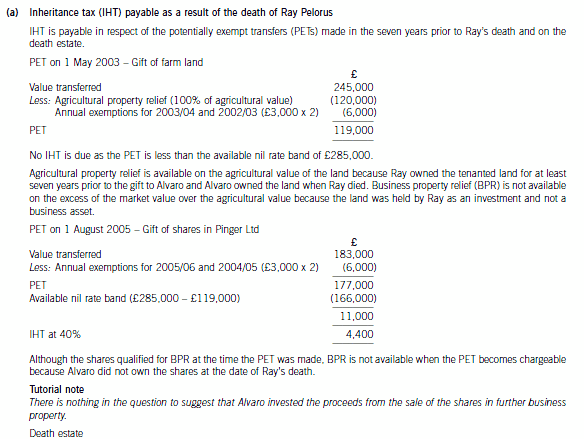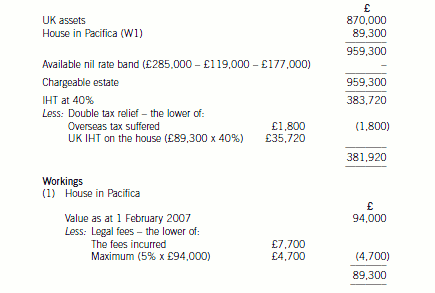ACCA考试P阶段课程有哪些特点,还有就是要考...
发布时间:2021-04-16
ACCA考试P阶段课程有哪些特点,还有就是要考什么具体科目,需要的专业水平是什么?
最佳答案
ACCA目前的科目设置如下,共16门
1.知识课程FUNDAMENTALS--KNOWLEDGEF1会计师与企业AccountantinBusinessABF
2管理会计ManagementAccountingMAF3财务会计FinancialAccountingFA2.技能课程FUNDAMENTALS—SKILLSF4公司法与商法CorporateandBusinessLawCLF5业绩管理PerformanceManagementPMF6税务TaxationTXF7财务报告FinancialReportingFRF8审计与认证业务AuditandAssuranceAAF9财务管理FinancialManagementFM
3.职业核心课程PROFESSIONAL—ESSENTIALSSBL战略商业领袖StrategicBusinessLeaderSBR战略商业报告StrategicBusinessReporting
4.职业选修课程PROFESSIONAL--OPTIONS四门任选二门P4高级财务管理AdvancedFinancialManagementAFMP
5高级业绩管理AdvancedPerformanceManagementAPMP6高级税务AdvancedTaxationATXP7高级审计与认证业务AdvancedAuditandAssuranceAAA
下面小编为大家准备了 ACCA考试 的相关考题,供大家学习参考。
(b) Advise the management of SCC Ltd of THREE strategies that should be considered in order to improve the
future performance of SCC Ltd. (6 marks)
(b) The four quadrants of the Boston-growth share matrix summarise expected profits and resultant cash flows and recommends
an outline strategy to follow which rather simplistically may be summarised as invest in stars, scrutinise the problem children,
milk the cows and divest the dogs.
Value Chain Analysis
It is vital that the management of SCC Ltd undertake a value chain analysis of each of its divisions in order to identify and
eliminate all non-value added activities, thereby improving profitability and cash flow without necessarily increasing turnover
or market share.
Divestment of the Footwear division
Serious consideration should be given to the divestment of the Footwear division. This will enable resources to be redirected
to divisions categorised as problem children i.e. the Industrial and Children’s divisions.
Support the Stars
As far as the Fashion division is concerned, it is obviously in a growth market and currently performing well. It is vital, given
the forecast performance of the other subsidiaries that the management of SCC Ltd do not concentrate on the poor performers
to the detriment of its only star.
1 Alvaro Pelorus is 47 years old and married to Maria. The couple have two children, Vito and Sophie, aged 22 and
19 years respectively. Alvaro and Maria have lived in the country of Koruba since 1982. On 1 July 2005 the family
moved to the UK to be near Alvaro’s father, Ray, who was very ill. Alvaro and Maria are UK resident, but not ordinarily
resident in the tax years 2005/06 and 2006/07. They are both domiciled in the country of Koruba.
On 1 February 2007 Ray Pelorus died. He was UK domiciled, having lived in the UK for the whole of his life. For the
purposes of inheritance tax, his death estate consisted of UK assets, valued at £870,000 after deduction of all
available reliefs, and a house in the country of Pacifica valued at £94,000. The executors of Ray’s estate have paid
Pacifican inheritance tax of £1,800 and legal fees of £7,700 in respect of the sale of the Pacifican house. Ray left
the whole of his estate to Alvaro.
Ray had made two gifts during his lifetime:
(i) 1 May 2003: He gave Alvaro 95 acres of farm land situated in the UK. The market value of the land was
£245,000, although its agricultural value was only £120,000. Ray had acquired the land on
1 January 1996 and granted an agricultural tenancy on that date. Alvaro continues to own the
land as at today’s date and it is still subject to the agricultural tenancy.
(ii) 1 August 2005: He gave Alvaro 6,000 shares valued at £183,000 in Pinger Ltd, a UK resident trading
company. Gift relief was claimed in respect of this gift. Ray had acquired 14,000 shares in
Pinger Ltd on 1 April 1997 for £54,600.
You may assume that Alvaro is a higher rate taxpayer for the tax years 2005/06 and 2006/07. In 2006/07 he made
the following disposals of assets:
(i) On 1 July 2006 he sold the 6,000 shares in Pinger Ltd for £228,000.
(ii) On 1 September 2006 he sold 2,350 shares in Lapis Inc, a company resident in Koruba, for £8,270. Alvaro
had purchased 5,500 shares in the company on 1 September 2002 for £25,950.
(iii) On 1 December 2006 he transferred shares with a market value of £74,000 in Quad plc, a UK quoted company,
to a UK resident discretionary trust for the benefit of Vito and Sophie. Alvaro had purchased these shares on
1 January 2006 for £59,500.
Alvaro has not made any other transfers of value for the purposes of UK inheritance tax. He owns the family house
in the UK as well as shares in UK and Koruban companies and commercial rental property in the country of Koruba.
Maria has not made any transfers of value for the purposes of UK inheritance tax. Her only significant asset is the
family home in the country of Koruba.
Alvaro and his family expect to return to their home in the country of Koruba in October 2007 once Ray’s affairs have
been settled. There is no double taxation agreement between the UK and Koruba.
Required:
(a) Calculate the inheritance tax (IHT) payable as a result of the death of Ray Pelorus. Explain the availability
or otherwise of agricultural property relief and business property relief on the two lifetime gifts made by Ray.
(8 marks)


(a) The following figures have been calculated from the financial statements (including comparatives) of Barstead for
the year ended 30 September 2009:
increase in profit after taxation 80%
increase in (basic) earnings per share 5%
increase in diluted earnings per share 2%
Required:
Explain why the three measures of earnings (profit) growth for the same company over the same period can
give apparently differing impressions. (4 marks)
(b) The profit after tax for Barstead for the year ended 30 September 2009 was $15 million. At 1 October 2008 the company had in issue 36 million equity shares and a $10 million 8% convertible loan note. The loan note will mature in 2010 and will be redeemed at par or converted to equity shares on the basis of 25 shares for each $100 of loan note at the loan-note holders’ option. On 1 January 2009 Barstead made a fully subscribed rights issue of one new share for every four shares held at a price of $2·80 each. The market price of the equity shares of Barstead immediately before the issue was $3·80. The earnings per share (EPS) reported for the year ended 30 September 2008 was 35 cents.
Barstead’s income tax rate is 25%.
Required:
Calculate the (basic) EPS figure for Barstead (including comparatives) and the diluted EPS (comparatives not required) that would be disclosed for the year ended 30 September 2009. (6 marks)
(a)Whilstprofitaftertax(anditsgrowth)isausefulmeasure,itmaynotgiveafairrepresentationofthetrueunderlyingearningsperformance.Inthisexample,userscouldinterpretthelargeannualincreaseinprofitaftertaxof80%asbeingindicativeofanunderlyingimprovementinprofitability(ratherthanwhatitreallyis:anincreaseinabsoluteprofit).Itispossible,evenprobable,that(someof)theprofitgrowthhasbeenachievedthroughtheacquisitionofothercompanies(acquisitivegrowth).Wherecompaniesareacquiredfromtheproceedsofanewissueofshares,orwheretheyhavebeenacquiredthroughshareexchanges,thiswillresultinagreaternumberofequitysharesoftheacquiringcompanybeinginissue.ThisiswhatappearstohavehappenedinthecaseofBarsteadastheimprovementindicatedbyitsearningspershare(EPS)isonly5%perannum.ThisexplainswhytheEPS(andthetrendofEPS)isconsideredamorereliableindicatorofperformancebecausetheadditionalprofitswhichcouldbeexpectedfromthegreaterresources(proceedsfromthesharesissued)ismatchedwiththeincreaseinthenumberofshares.Simplylookingatthegrowthinacompany’sprofitaftertaxdoesnottakeintoaccountanyincreasesintheresourcesusedtoearnthem.Anyincreaseingrowthfinancedbyborrowings(debt)wouldnothavethesameimpactonprofit(asbeingfinancedbyequityshares)becausethefinancecostsofthedebtwouldacttoreduceprofit.ThecalculationofadilutedEPStakesintoaccountanypotentialequitysharesinissue.Potentialordinarysharesarisefromfinancialinstruments(e.g.convertibleloannotesandoptions)thatmayentitletheirholderstoequitysharesinthefuture.ThedilutedEPSisusefulasitalertsexistingshareholderstothefactthatfutureEPSmaybereducedasaresultofsharecapitalchanges;inasenseitisawarningsign.InthiscasethelowerincreaseinthedilutedEPSisevidencethatthe(higher)increaseinthebasicEPShas,inpart,beenachievedthroughtheincreaseduseofdilutingfinancialinstruments.Thefinancecostoftheseinstrumentsislessthantheearningstheirproceedshavegeneratedleadingtoanincreaseincurrentprofits(andbasicEPS);however,inthefuturetheywillcausemoresharestobeissued.ThiscausesadilutionwherethefinancecostperpotentialnewshareislessthanthebasicEPS.
6 Certain practices have developed that threaten to damage the integrity and objectivity of professional accountants and
the reputation of the accounting profession.
Required:
Explain the following practices and associated ethical risks and discuss whether current ethical guidance is
sufficient:
(a) ‘lowballing’; (5 marks)
6 CERTAIN PRACTICES
Tutorial note: The answer which follows is indicative of the range of points which might be made. Other relevant material will
be given suitable credit.
(a) ‘Lowballing’
Explanation of term
‘Lowballing’ is the ‘loss-leading’ practice in which auditors compete for clients by reducing their fees for statutory audits.
Lower audit fees are then compensated by the auditor carrying out more lucrative non-audit work (e.g. consultancy and tax
advice). Audits may even be offered for free.
Such ‘predatory pricing’ may undercut an incumbent auditor to secure an appointment into which higher price consultancy
services may be sold.
Ethical risks
There is a risk of incompetence if the non-audit work does not materialise and the lowballing firm comes under pressure to
cut corners or resort to irregular practices (e.g. the falsification of audit working papers) in order to ‘keep within budget’.
However, a lack of audit quality may only be discovered if the situation arises that the company collapses and the auditors
are charged with negligence.
If, rather than comprise the quality of the audit, an audit firm substantially increases audit fees, a fee dispute could arise. In
this case the client might refuse to pay the higher fee. It could be difficult then for the firm to take the matter to arbitration
if the client was misled. Thus an advocacy threat may arise.
Financial dependence is a direct incentive that threatens independence. A self-interest threat therefore arises when, having
secured the audit, the audit firm needs the client to retain its services in order to recoup any losses initially incurred.
The provision of many other services gives rise to a self-review threat (as well as a self-interest threat).
Sufficiency of current ethical guidance
In current ethical guidance, the fact that an accountancy firm quotes a lower fee than other tendering firms is not improper,
providing that the prospective client is not misled about:
– the precise range of services that the quoted fee is intended to cover; and
– the likely level of fees for any other work undertaken.
This is clearly insufficient to prevent the practice of lowballing.
Legal prohibitions on the provision of many non-audit services (e.g. bookkeeping, financial information systems design and
implementation, valuation services, actuarial services, internal audit (outsourced), human resource services for executive
positions, investment and legal services) should make lowballing a riskier pricing strategy. This may curb the tendency to
lowball.
Lowballing could be eliminated if, for example, auditors were required to act ‘exclusively as auditors’. Although regulatory
environments have moved towards this there is not a total prohibition on non-audit services.
声明:本文内容由互联网用户自发贡献自行上传,本网站不拥有所有权,未作人工编辑处理,也不承担相关法律责任。如果您发现有涉嫌版权的内容,欢迎发送邮件至:contact@51tk.com 进行举报,并提供相关证据,工作人员会在5个工作日内联系你,一经查实,本站将立刻删除涉嫌侵权内容。
- 2021-12-29
- 2021-03-11
- 2021-04-23
- 2021-03-12
- 2021-03-12
- 2021-04-20
- 2021-05-12
- 2021-03-12
- 2021-01-01
- 2021-05-07
- 2021-03-10
- 2021-03-12
- 2021-07-18
- 2021-03-11
- 2021-02-11
- 2021-01-01
- 2021-04-24
- 2021-03-11
- 2021-07-14
- 2021-03-11
- 2021-12-31
- 2021-05-11
- 2021-03-10
- 2021-03-12
- 2021-05-11
- 2021-06-15
- 2021-06-05
- 2021-03-12
- 2021-03-11
- 2021-05-06